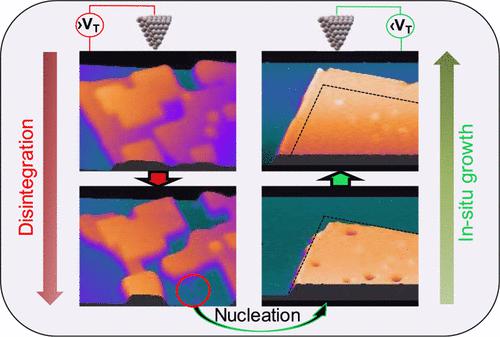当前位置:
X-MOL 学术
›
J. Phys. Chem. C
›
论文详情
Our official English website, www.x-mol.net, welcomes your feedback! (Note: you will need to create a separate account there.)
In Situ Growth and Bias-Dependent Modification of NaBr Ionic Layers on Ag(111)
The Journal of Physical Chemistry C ( IF 3.7 ) Pub Date : 2022-06-21 , DOI: 10.1021/acs.jpcc.2c03582 Abhijit Bera 1 , Karina Morgenstern 1
The Journal of Physical Chemistry C ( IF 3.7 ) Pub Date : 2022-06-21 , DOI: 10.1021/acs.jpcc.2c03582 Abhijit Bera 1 , Karina Morgenstern 1
Affiliation

|
Although the formation of insulating ionic layers on metal surfaces has been well studied, their growth mechanisms are still controversial. Here, we report several innovative approaches to trigger in situ growth to understand this growth mechanism. The modification of the layer and its in situ growth is followed by time-lapsed scanning tunneling microscopy at room temperature with atomic resolution. The NaBr molecules form bilayer and trilayer islands when deposited at room temperature. These stable layers begin to disintegrate when the voltage exceeds the threshold voltage during scanning. The molecules released from the modified layer subsequently attach to the preexisting layer in a predefined scan region. Scanning of two neighboring trilayer islands traps the mobile molecule between them, leading to their coalescence. Time-lapsed measurements offer a step-by-step realization of the in situ controlled growth of an ionic layer at the atomic scale.
中文翻译:

Ag(111) 上 NaBr 离子层的原位生长和偏压相关改性
尽管已经对金属表面绝缘离子层的形成进行了很好的研究,但它们的生长机制仍然存在争议。在这里,我们报告了几种触发原位生长的创新方法,以了解这种生长机制。该层的修改及其原位生长之后是在室温下具有原子分辨率的延时扫描隧道显微镜。NaBr 分子在室温下沉积时形成双层和三层岛。当扫描期间电压超过阈值电压时,这些稳定层开始分解。从改性层释放的分子随后在预定义的扫描区域中附着到预先存在的层上。扫描两个相邻的三层岛将移动分子捕获在它们之间,从而导致它们的聚结。
更新日期:2022-06-21
中文翻译:

Ag(111) 上 NaBr 离子层的原位生长和偏压相关改性
尽管已经对金属表面绝缘离子层的形成进行了很好的研究,但它们的生长机制仍然存在争议。在这里,我们报告了几种触发原位生长的创新方法,以了解这种生长机制。该层的修改及其原位生长之后是在室温下具有原子分辨率的延时扫描隧道显微镜。NaBr 分子在室温下沉积时形成双层和三层岛。当扫描期间电压超过阈值电压时,这些稳定层开始分解。从改性层释放的分子随后在预定义的扫描区域中附着到预先存在的层上。扫描两个相邻的三层岛将移动分子捕获在它们之间,从而导致它们的聚结。


























 京公网安备 11010802027423号
京公网安备 11010802027423号